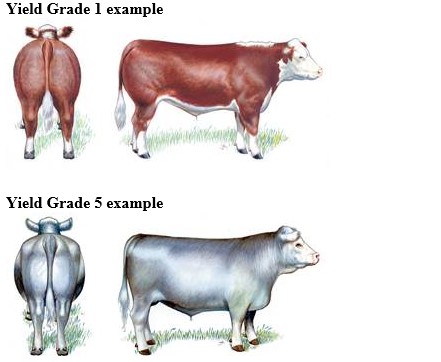Tue, 06 Sep 2022 09:08:40 CDT

Mark Johnson, Oklahoma State University Extension Beef Cattle Breeding Specialist, offers herd health advice as part of the weekly series known as the "Cow Calf Corner" published electronically by Dr. Peel, Mark Johnson, and Paul Beck. Today, Johnson is talking about beef yield grades and retained ownership.
United States Department of Agriculture (USDA) Beef Yield Grades assigned to beef carcasses indicate the percentage of trimmed, red meat yield from the round, loin, rib and chuck of a beef carcass. Beef Yield Grades are based on: 1) amount of adjusted Fat Thickness (external fat) measured at the last rib of the hanging carcass, 2) the percentage of Kidney, Heart and Pelvic (KPH) fat found inside the abdominal cavity of the carcass, 3) the size of the ribeye relative to the 4) hot carcass weight. In short, Yield Grades indicate cutability and are based on the degrees of fatness and muscularity of the carcass. At finishing, heavier muscled, trimmer live cattle will harvest yielding higher cutability carcasses with lower numerical Yield Grades.
USDA Yield Grades from best to worst are:
Yield Grade 1 = highest cutability
Yield Grade 2
Yield Grade 3
Yield Grade 4
Yield Grade 5 = lowest cutability
With respect to the beef carcass value, USDA Yield Grades do not provide as much economic incentive as Beef Quality Grades. Although there are some carcass value marketing systems (grids) that do give more economic incentive to cutability, it is important to remember that virtually all beef cuts sold at retail are marketed on a closely trimmed (.10 inch or less) basis. Trimming of excessive fat can be done after harvest. Quality Grades based on marbling are a result of growth and development prior to harvest and can’t be “fixed” to the extent which excess fat can be trimmed away. That being said, Yield 4 and 5 fed cattle represent waste and inefficiency in beef production and receive substantial discounts in virtually all grid based marketing systems.
Conclusion
Selection tools in the form of EPDs are available to breeders. Pedigreed seedstock is readily available with predicted genetic values for Ribeye Size, Hot Carcass Weight, Fat Thickness and Marbling Scores. As stated earlier in this series, operations currently making the decision on whether or not to retain ownership through finishing and market fed cattle on a carcass value basis should answer several questions. One of the most important: How much selection pressure have I put on the EPDs influencing carcass value in past bull selection?

















